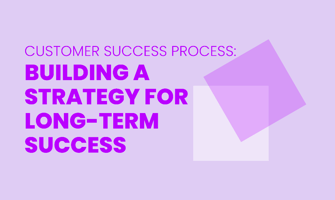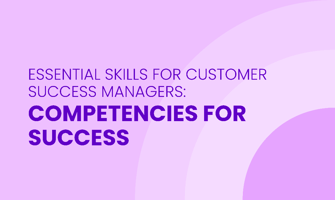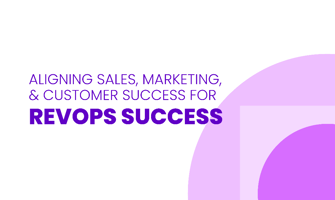Does your business struggle to keep customers happy and reduce support tickets? A formal Customer...
Customer Success Technology: Tools and Platforms for Success Management
Imagine having a friendly team that always makes sure you're happy with what you bought. That's what Customer Success teams do! They keep customers satisfied and loyal after a sale.
To do this well, they need special tools and platforms. These tools help manage customer data, track usage, gather feedback, and more.
In this article, we'll look at the top technology tools that make Customer Success teams so effective. These tools help ensure customers always have a great experience.
Key Components of Customer Success Tech
Success teams benefit greatly from customer success technology. It helps manage customer data and interactions.
Key features include:
Customer success CRM
Live chat
Customer support tools
These features enhance customer experience and satisfaction. Customer success software automates tasks and tracks success metrics. It provides a complete view of the customer journey. This aids customer success managers in their roles.
Data analytics and reporting are very important in these platforms. They help understand customer feedback and needs. This tech boosts true customer engagement. It uses strategies and insights to improve relationships and drive sales.
During a company’s growth phase, these tools streamline customer retention. They inform playbooks for success practitioners. They ensure the company can respond to different use cases. This contributes to long-term growth and product-market fit in the SaaS industry.
By integrating technology stacks, customer success managers make sure the business delivers real value and retains customers effectively.
Essential Tools for Customer Success Teams
Customer Success Software
Customer success software helps teams manage customer relationships. It automates data tracking and gives insights from customer feedback.
Look for features like:
Automation capabilities
Reporting tools
Live chat options
This software shows all customer data. It helps managers spot churn risks and improve engagement. Integration with ticketing systems and CRM makes interactions smoother and more efficient.
Playbooks and metrics from this technology guide practitioners through customer journeys. This ranges from sales to long-term growth.
These tools support retention and engagement. They ensure communication is smooth and organize customer experiences, boosting satisfaction.
Teams can customize support strategies based on use cases and product fit. This ensures strategies align with company goals for maximum value.
Service Management Platforms
Service management platforms should offer core features. These include managing customer data, tracking interactions, and monitoring customer health.
These tools help teams understand customers' needs and experiences. Integrating these platforms with other software makes operations smoother. This allows for seamless data flow and better customer support.
Businesses should consider:
Compatibility with current tools
Ease of use
Ability to track metrics and feedback
Platforms should also offer:
Customer communication
Live chat
Strong customer service features
Good platforms can create playbooks to guide customer strategies. This helps boost engagement and long-term growth. They should support success practitioners in understanding use cases. They also ensure the sales team aligns with customer strategies.
Proper platforms improve customer relationships and satisfaction. They help managers drive business value and a successful product-market fit.
Customer Support Tools
When choosing customer support tools, success teams should look for features like live chat, automation, and reporting.
These tools can improve customer interactions and offer insights to boost satisfaction and retention. Customer support software helps provide a smooth customer experience by offering quick help and resolving issues fast.
Integrations with other tech tools are also important. For example, linking customer success CRM with support tools gives a complete view of the customer's journey. This allows success teams to match customer data with success metrics, create useful playbooks, and engage customers effectively.
Connecting customer support tools with sales and product systems can show how customers use products and inform managers about their needs. This level of integration supports long-term growth and customer relationships. It also helps teams provide personalized support and grow business value.
Proper tools can help managers develop strategies to improve the customer experience and meet business goals. By using customer feedback, these tools support the company's retention goals and success measures.
Building an Effective Technology Stack
Company success teams should look at success metrics, customer needs, and customer data when choosing tools for their tech setup. Customer success software should better customer relationships through:
Live chat
Playbooks
Customer support
These tools should match business goals and product-market fit. They should also improve customer experience, engagement, and tech skills.
Companies need to check if new tools work well with their current ones. Customer success managers should see if the new software integrates with CRM systems and fits various use cases in their SaaS products. Knowing the customer journey helps ensure good customer interaction and true engagement.
For ongoing updates and improvements, success teams should:
Update software regularly
Monitor success metrics
Frequently gather customer feedback
Companies should make sure their tools provide a complete view of the customer experience. This helps with long-term growth, customer retention, and making better strategies. Regular training for the sales team and checking out new tools will improve customer success technology and the overall customer relationship.
Top Customer Success Platforms
Gainsight
Gainsight helps customer success teams improve their client relationships. It offers a platform with features designed to boost customer retention and satisfaction. These features include:
Customer success CRM
Customer data management
Detailed analytics
Gainsight also provides tools for tracking customer interactions and feedback. This helps success teams understand the entire customer journey. Features like live chat and playbooks allow managers to address customer needs quickly and reduce churn.
The platform can integrate with other customer success tools like support and service platforms. This ensures a seamless workflow and a consistent customer experience.
By using Gainsight, companies can enhance customer satisfaction and achieve long-term growth through better engagement and retention.
Software Integrations in Customer Success
Integrating multiple tools in customer success strategies helps teams see all customer data in one place. This gives a full view of the customer journey.
With integration, success managers can track metrics, understand needs, and provide better support using tools like live chat.
This makes operations smoother by automating interactions and reducing manual tasks.
For example, linking a CRM with a ticketing system lets teams manage feedback and support requests efficiently. This boosts customer satisfaction.
Challenges include ensuring all tools work together and getting sales and success teams to adopt new technology.
To overcome these, teams need a solid strategy and should involve everyone in the process. Trials and demos help gather knowledge and focus on success metrics.
This ensures the technology fits the company's growth phase and product-market fit.
Viewing customer data holistically enhances relationships and supports long-term growth.
Optimizing Success Metrics with Tech
Customer success can improve by using technology to track and analyze metrics.
Customer success software helps teams collect and manage customer data. This provides insights for relationships and engagement.
With better data, you can improve customer retention and satisfaction. Use tools like:
Customer success CRM
Live chat
Customer feedback systems
These tools optimize key metrics (KPIs).
Integrating technology across platforms gives a full view of customer interactions. This enhances their experience.
Success teams can use data to create strategies that align with business goals. This coordination helps managers and sales teams understand customer needs better and improve support.
The technology evolves as the company grows, aiming for a good fit with the market.
Linking customer data and experience helps companies see true engagement and support long-term growth.
A well-chosen tech stack is important for customer satisfaction throughout the journey.
Strategic Account and Opportunity Management
Effective strategic account management boosts revenue growth and keeps customers loyal. It focuses on deepening customer relationships and using customer success technology.
Customer success teams use Customer Success CRM software to:
Manage customer data
Track customer interactions
Identify high-value opportunities
These teams use playbooks and success metrics to measure customer satisfaction and engagement, ensuring long-term growth.
The organization uses various tech tools like customer success platforms and feedback systems to get a full view of customer experiences and track customer health.
To manage strategic accounts, customer success managers focus on personalized strategies. They closely monitor the customer journey through live chat and other service tools.
By doing this, the company:
Ensures true customer engagement
Improves customer support
Enhances the overall customer experience
This tech-driven, strategic approach helps the company fit the market during different growth phases and retain customers through targeted communications and support.
Enhancing Customer Education Efforts
Customer success teams can boost customer education using technology like customer success software.
Tools such as live chat and SaaS solutions help manage customer data and create interactive playbooks.
To make education engaging, companies can use strategies like personalized learning paths and customer journey maps.
Success CRMs track customer interactions and tailor content to specific needs.
Customer feedback is important. Tools like customer success CRM and support platforms capture valuable insights.
This feedback helps improve educational content and boosts customer satisfaction.
Customer success managers should work with the sales team to ensure educational material adds real business value.
By integrating this knowledge, organizations can achieve true customer engagement and maintain strong relationships during different growth phases.
This broad view of customer education helps deliver impactful experiences, driving retention and long-term growth.
Leveraging Customer Success Tech for Valuable Insights
Customer success technology gathers customer insights. It tracks data like product usage, feedback, and success metrics.
Teams collect data from live chats, service tickets, and usage analytics using this software. Important features include automation, reporting tools, and health tracking to make data useful.
Tools like customer success CRM provide a complete view of customer interactions. This helps predict churn and improve satisfaction.
Integrating various tools offers a full understanding of the customer journey. Combining support, communication, and learning systems creates a smooth strategy. This boosts engagement and retention.
Managers can then create playbooks and strategies for different situations. This enhances growth in both the short and long term. This tech stack aligns with a company's goal of true customer engagement and maximizing business value.
How Technology Helps Boost Revenue
Data analytics tools help drive revenue growth. They give customer success teams insights into customer data. These insights identify new sales opportunities, optimize sales strategies, and improve the customer experience.
Customer relationship management systems (CRM) increase revenue. They enhance customer retention and loyalty, leading to more stable income for companies.
Automation software simplifies operations. It makes repetitive tasks faster and more accurate. This increases efficiency and lets success teams focus more on customer engagement.
Customer success technology, like live chat and CRM, boosts customer satisfaction. It offers timely support and better understands customer needs. Success practitioners use this data to fine-tune their strategies.
This complete view of customer interactions helps achieve true customer engagement. SaaS companies benefit, especially in growth and product-market fit areas. This leads to long-term growth and higher revenue.
Streamlining Operations through Automation
Automation technologies help customer success teams by handling routine tasks.
They take care of customer data and live chat responses.
For example:
Customer success software tracks customer interactions.
It also tracks success metrics.
This frees up time for customer success managers to build customer relationships.
However, businesses often face challenges when using automation:
Lack of awareness among company leaders.
Technical difficulties.
Customer success teams can manage these by:
Using detailed playbooks.
Providing training for everyone to understand the tool's benefits.
Automation also improves accuracy:
It reduces errors in customer feedback collection.
Offers predictive analytics.
This helps success practitioners identify churn risks faster.
As a result, the company benefits through better customer retention.
Automation speeds up customer service responses and ensures timely, data-driven interactions.
Adopting a strong customer success technology stack can boost long-term customer satisfaction and business value.
This approach helps both sales and success teams create strategies for true customer engagement.
Considerations for Pricing and Scalability
Scaling customer success technology for a growing customer base involves several costs. These include software, extra tools, and technical support. Pricing often adjusts based on usage, with many providers offering tiered pricing for different needs.
Using advanced Customer Success CRM or customer engagement tools can increase costs. However, it also improves customer satisfaction and retention. Volume discounts or tiered pricing models are common, especially for large companies needing extensive tools. These models help customer success teams and managers handle customer data and interactions effectively during business growth.
This flexibility helps companies achieve true customer engagement without large budgets. When Customer Success managers and practitioners use these tools, they can boost customer relationships and overall experience, ensuring long-term growth.
Effective playbooks and success metrics also support scaling efforts. They align customer success strategies with company goals and the customer's journey. This approach provides customer support and business value, creating a complete view of customer needs and satisfaction.
Future Trends in Customer Success Technology
Customer success technology is changing fast. This affects how success teams work. New technologies like artificial intelligence (AI) and predictive analytics will shape customer success in 5-10 years.
AI can help by automating tasks and analyzing customer data. It can also provide real-time support through live chat. As a result, customer interactions and satisfaction will improve. Teams will understand customer behavior better, allowing for more personalized experiences.
Predictive analytics helps by forecasting customer needs and success metrics. This creates targeted plans and boosts customer engagement. It also lets teams spot churn risks early and offer tailored support. This benefits company growth.
Customer success software will keep adding advanced tools. These tools give a full view of customer journeys and make processes easier for managers. By using these technologies, businesses can build better customer relationships and improve retention. This leads to long-term growth and shows real customer engagement and value.
FAQ
What are some popular customer success technology tools?
Some popular customer success technology tools include Gainsight, Salesforce Service Cloud, Zendesk, Totango, and ChurnZero.
How can customer success platforms help me track customer engagement?
Customer success platforms can help track customer engagement through analytics and data tracking tools. These platforms offer insights on customer actions, interactions, and feedback, allowing you to proactively engage with customers. Examples include tracking email open rates, product usage metrics, and customer satisfaction scores.
What are some key features to look for in a customer success management tool?
Some key features to look for in a customer success management tool include proactive alerts, customer health scoring, and in-app guidance. Tools like Gainsight and ChurnZero offer these features to enhance customer success efforts.
How can customer success technology help improve overall customer satisfaction?
Customer success technology can improve overall customer satisfaction by providing personalized support, tracking customer interactions, and identifying areas for improvement. For example, using customer success platforms to automate proactive outreach and address customer needs in real-time can enhance the overall customer experience.
Are there any customer success platforms specifically designed for small businesses?
Yes, there are customer success platforms specifically designed for small businesses such as Gainsight PX and ClientSuccess.




